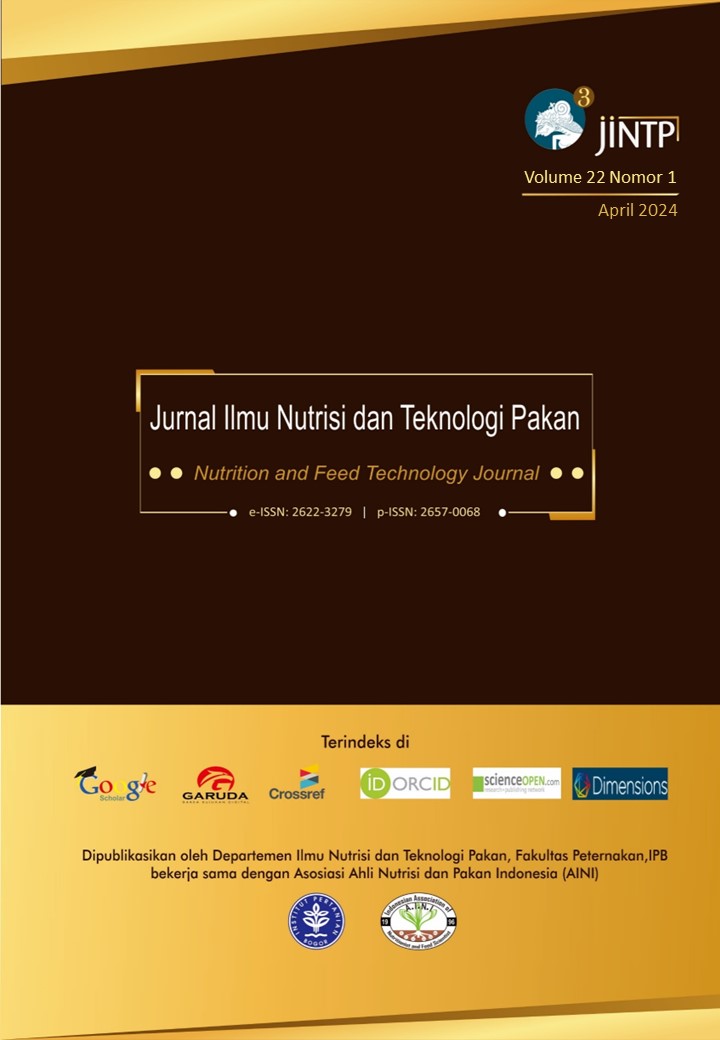Evaluasi Kualitas Nutrien Dedak Padi di Provinsi Jawa Barat Berdasarkan Perbedaan Musim terhadap Standar Nasional Indonesia
The Nutrient Quality Evaluation of Rice Bran in West Java Province Based on Seasonal Differences Against Indonesian National Standards
Abstract
This research aimed to analyze differences in the nutrient quality of rice bran during the rainy and dry seasons at all user levels in West Java Province for the 2016-2020 period compared to SNI 3178 in 2013. This research used secondary data from 306 samples from two laboratories, Feed Quality and Certification (BPMSP) Bekasi and Feed/Feed Ingredient Quality and Safety Testing Center (BPMKP/BP) Cikole Lembang, West Java. this study, used frequency distribution to provide a simple description of data collection, in contrast, rice bran users used percentages of test data suitable for rice bran according to SNI 3178 of 2013. The results showed that the conformity of rice bran nutrients to SNI in the dry season was better compared to the rainy season. The best percentage of SNI conformity at the rice bran user level was large users, suppliers, small users, and other users respectively.
Key words: quality of rice bran, rice bran, SNI rice bran
Downloads
References
[AOAC]. Association of Official Analytical Chemists.2005. AOAC Official Methods Chapter 4 Animal Feed. Official Methods of Analysis of AOAC International. Maryland (USA): AOAC International
Agustono B, Lamid M, Ma’ruf A & Purnama MTE. 2017. Identifikasi limbah pertanian dan perkebunan sebagai bahan pakan inkonvensional di Banyuwangi. Jurnal Medik Veteriner 1 (1) : 12-22
Arno G, Dupe ZL & Mustofa MA. 2012. Kajian awal musim hujan dan awal musim kemarau di Indonesia. Jurnal Meteorologi Dan Geofisika 13 (1): 1-8.
Bodie AR, Micciche AC, Atungulu GG, Rothrock MJ Jr & Ricke SC. 2019. Current trends of rice milling by products for agricultural applications and alternative food production systems. Frontiers in Sustainable. Food System. 3:47. doi: 10.3389/fsufs.2019.00047
[BPS] Badan Pusat Statistik . 2023. Luas Panen dan Produksi Padi di Indonesia 2022. ISSN: 2797-7897. Jakarta (ID) : BPS.
[BSN] Badan Standarisasi Nasional. 2013. SNI 3178 tahun 2013 Dedak Padi. Jakarta (ID): BSN
[BSN]Badan Standarisasi Nasional. 1992. SNI 01-2891 Tahun 1992. Cara Uji Makanan dan Minuman. Jakarta (ID): BSN
Cahyaningtyas, A, Azizah N & Herlina N. 2018. Evaluasi dampak perubahan iklim terhadap produktivitas padi (Oryza sativa l.) di kabupaten Gresik. Jurnal Produksi Tanaman. 6 ( 9) : 2030-2037
Firmansyah. 2022. Teknik pengambilan sampel umum dalam metodologi penelitian: literature review. Jurnal Ilmiah Pendidikan Holistik (JIPH) 1 (2): 85-114
Han S-W, Chee K-M & Cho S-J. 2014.Nutritional quality of rice bran protein in comparison to animal and vegetable protein, Food Chemistry 172 :766-769, doi: http://dx.doi.org/10.1 016/ j.foodchem.2014.09.127
Hidayat C, Sumiati & Iskandar S. 2015. Kualitas fisik dan kimiawi dedak padi yang dijual di toko bahan pakan di sekitar wilayah Bogor. Prosiding Seminar Nasional Teknologi Peternakan dan Veteriner. Jakarta (ID): Badan Penelitian dan Pengembangan Pertanian
Ilias, NN, Rozalli NHM, Thuy Vy NH & Yi EH. 2020. Rice bran of different rice varieties in Malaysia: Analysis of proximate compositions, antioxidative properties and fatty acid profile for data compilation. Advances in Agriculural in Food Research Journal 1(2): a0000164 https://doi.org/10.36877/aafrj.a0000164
Maesaroh, E, Martin RSH, Jayanegara A, Aminingsih T, Nahrowi N. 2023. Evaluasi fisik dan kimia dedak padi pada berbagai level penambahan sekam. Jurnal Ilmu Nutrisi dan Teknologi Pakan. 21(1): 41-48
Miftahudin, Liman & Fathul F. 2015. Pengaruh masa simpan terhadap kualitas fisik dan kadar air pada wafer limbah pertanian berbasis wortel. Jurnal Ilmiah Peternakan Terpadu. 3(3): 121-126
Mila JR & Sudarma IMA, 2021. Analisis kandungan nutrisi dedak padi sebagai pakan ternak dan pendapatan usaha penggilingan padi di Umalulu, Kabupaten Sumba Timur. Buletin Peternakan Tropis 2(2): 90-97 Doi: https://doi.org/10.31186/bpt.2.2.90-97
Mustafidah H & Imantoyo ASS. 2020. Pengembangan aplikasi uji T satu sampel. Jurnal Informatika. 8(2): 245–251.
Nurfitri Y, Yuliani MGA, Wahyuni RS, Lamid M, Al-Arif MA & Aksono EB. 2020. Potensi dedak padi yang difermentasi dengan enzim fitase dalam pakan basal terhadap kolesterol total darah ayam petelur. Journal of Basic Medical Veterinary. 9 (2): 92-98
Suryani HF & Luthfi N. 2022. Evaluasi kualitas nutrisi dedak padi dari pemasok bahan pakan di Kabupaten Semarang. Journal of Animal Center. 4( 1): 26-32Surmaini E & Syahbuddin H . 2016. Kriteria awal musim tanam: tinjauan prediksi waktu tanam padi di Indonesia. Jurnal Litbang Pertanian 35(2): 47-56. DOI: 10.21082/jp3.v35n2.2016.p47-56
Superianto S, Harahap AE & Ali A. 2018. Nilai nutrisi silase limbah sayur kol dengan penambahan dedak padi dan lama fermentasi yang berbeda. Jurnal Sain Peternakan Indonesia 13 (2): 172-181 DOI: https://doi.org/10.31186/jspi.id.13.2.172-181
Wahab A, Syahid A & Junaedi. 2021. Penyajian data dalam distribusi frekuensi dan aplikasinya pada ilmu pendidikan. Education and Learning Journal. 2(1): 40-48.
Widiyastuti T, Munasik M, & Susanti E. 2023. Karakteristik dedak padi Di wilayah Purwokerto dan sekitarnya. Prosiding Seminar Nasional Teknologi dan Agribisnis Peternakan X. Purwokerto (ID): Universitas Jenderal Soedirman.
Zepner L, Karrasch P, Wiemann F & Bernard L. 2020 ClimateCharts.net – an interactive climate analysis web platform, International Journal of Digital Earth, 14(3):338-356 DOI: 10.1080/17538947.2020.1829112
Zullaikah S, Pramuji B, Prasetyo EN, Wicaksono ST, Nikmah H, Haryanto, Jannah A, Wardhana AGS, Prakoso A, Mujiburrosyid A & et al. 2022. Teknologi pembuatan pakan konsentrat sapi potong sesuai Standar Nasional Indonesia (SNI) berbasis limbah pertanian. Sewagati. 6(5): 626–636. https:// doi.org/10.12962/j26139960.v6i5.398
Copyright (c) 2024 I B Wibowo, I G Permana, Nahrowi

This work is licensed under a Creative Commons Attribution 4.0 International License.
The authors of the submitted manuscript have to understand and agree that the copyrights published are held by Jurnal Ilmu Nutrisi dan Teknologi Pakan. Copyrights includes rights in reproducing, distributing and selling every section of articles in all forms and media. The copyright transfer form is signed by the corresponding author. The author”
• Creative Commons Attribution (CC BY)
you are allowed to:
Share – copy and redistribute the material in any medium or format
Adapt – remix, transform, and build upon the material
for any purpose, even commercially.
The licensor cannot revoke these freedoms as long as you follow the license terms.
Jurnal Ilmu Nutrisi dan Teknologi Pakan (Nutrition and Feed Technology Journal)

This work is licensed under a Creative Commons Attribution 4.0 International License.












